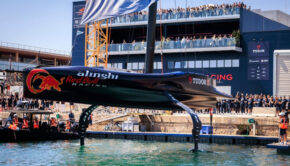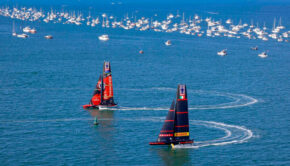AMERICA’S CUP Issues Elevate To New Highs
Published on June 27th, 2013
It was either wishful thinking, or America’s Cup regatta director Iain Murray was unaware of the irony in his choice of words.
In explaining the way forward for the beleaguered event after the competitors failed to reach an agreement over the safety recommendations following four days of mediation, Murray said he would push on and implement all 37 recommendations regardless. To do so he will need to issue a regatta notice “harmonising the various rule documents”.
It was a slippery way of saying the Protocol that governs the event, the class rule, and racing rules would all need to be altered to accommodate these new safety measures. The irony is, such a move is only going to create further disharmony in what has been a tense and fraught build-up to the 34th America’s Cup.
We’re now less than two weeks out from the start of racing and it is almost certain Team New Zealand and Luna Rossa will lodge a protest with the international jury once the regatta notice is issued. The Italians are even making noises about taking their fight to the US Supreme Court – a prospect that will further enhance the view that the America’s Cup is more about courtroom battles than on-water duels.
As was revealed in the Herald on Monday, there is only one proposal that Team New Zealand object to outright – and that is the use of rudder elevators. Under the class rule drawn up in 2010 – a document which sets down the design parameters for the AC72 – the use of trim tabs or moveable winglets on rudders were prohibited. But the new safety provisions allow for rudder elevators, which are winglets that help control the high-powered catamarans when they get airborne on foils.
The recommendation appears to favour defenders Oracle, who have been trialling the illegal modifications during their testing to help them foil more stably.
Team New Zealand are prepared to accept the wind limits being significantly reduced, they’re prepared to accept the financial and logistical challenges of adhering to the recommendations, and while they grizzled rather loudly, they’re now even prepared to accept the reduced racing format.
But allowing retrospective changes to be made to the design rules because one team cannot get their foiling right within the existing set of rules is a bridge too far for the Kiwis.
It should be a cut and dried case. To make changes to the design rules a week and a half out from the start of racing to accommodate one team is ludicrously unfair. The problem is, given the proposed changes being made under the banner of safety, it has become a highly emotive discussion. Every argument has been countered with “but a man has died”.
No one has lost sight of the terrible tragedy that occurred on May 9. The death of Andrew Simpson will cast a shadow on this event long after the teams have packed up and left San Francisco Bay. But it seems some people have lost sight of the fact that the Artemis boat on which Simpson died was a non-foiling boat.
Rudder elevators would not have prevented the Artemis capsize. While the specific cause of the accident has not been released by authorities, it has become apparent the crash was a result of faulty engineering or faulty construction.
And that bitter irony is not lost on Team New Zealand. Full story
Quotable: John Craig, Principal Race Officer, 34th America’s Cup, “One of the examples in the safety recommendations is to make symmetrical elevators on the rudders. The elevators are lifting wings on the rudders that you can’t adjust, and they are currently asymmetrical because they can’t go outside the beam of the boat, so you have one lifting elevator that’s shorter than the other. Iain Murray’s recommendation was to increase the size of those, and you could make them symmetrical and the same size. Some of the teams are saying, “We’re happy with where we are, we don’t think that’s a change we need to make.” Maybe the negotiation is just to make them a little bigger because the bigger they are, the more stable they are.” Full interview








 We’ll keep your information safe.
We’ll keep your information safe.